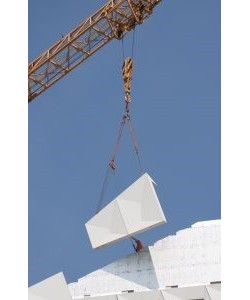The focus on the value of data in offsite construction is understandable but, cautions Lee Mullin of Autodesk, the importance of geometric design information cannot be overlooked
In the 12 months since release in the UK of the Farmer Review, Modernise or Die, the perception has grown that offsite construction is where the industry is moving. However, if you discuss this with many contractors, offsite is only considered as an option when a tight schedule or other constraints make it necessary, so it is often seen as an afterthought.
Some contractors, such as Laing O’Rourke, have gone ‘all in’ on an offsite strategy, placing it at the front and centre of their thinking, building their own factory at Steetley and encouraging early engagement with clients and designers to look at how to build differently. It’s an approach that has been questioned by many in the industry over the last decade, but is now looking like a shrewd move as government reports endorse offsite, while the rest of the industry catches up.
While benefits can be seen by adopting an offsite strategy at Stage 4, the greatest benefits really occur when consideration for offsite is taken at a much earlier stage and embedded as part of the design process as the recent Digital Built Britain reports from Bryden Wood encourages.
So, if adoption requires design process changes then it seems like a good time to adopt BIM processes. UK standards like PAS1192-2 are largely about improving the flow of information and reducing the chances of working on outdated or incomplete information, essential to ensuring assembly on site is successful.
Much of the discussion around BIM in the UK has been around the importance of data and using standards like COBie. Now while this is very important for a range of tasks like operations and maintenance later in the process, or even procurement earlier in the process, offsite succeeds or fails based on the quality of the geometric design information.
As we move more towards a manufacturing process in building and infrastructure delivery, we need to be much more aware of clash detection, building in tolerances, expansion joints and being more aware of materials and interfaces to maintain quality for the lifecycle of the built asset. Imagine if car manufacturers built their latest models using the same quality design information as construction, and didn’t run the thousands of checks that they do to ensure quality. Would you still feel confident driving them the same way?
We have always had a lax approach to designing to tolerances and then verifying construction to within those tolerances, and even following up rigorously when errors are made due to schedules, with many projects having a ‘near enough’ approach. This simply doesn’t work with a manufacture and assembly approach to building. The knock-on effect of uncoordinated and badly thought-out design can range from elements simply not fitting, requiring manual changes on-site or waiting several weeks for replacements, through to problems during use with leaks, reduced thermal performance and parts that become unmaintainable.
This already happens today with offsite components like doors and windows. On a larger-scale, whether panelised, volumetric or modular construction, you would get what in the manufacturing world is known as tolerance stack-up, where items are built to say –/+ 3mm. When this effect is multiplied across an assembled part, the whole thing could be centimetres out, which may affect how parts fit. Two solutions to this are to build to higher tolerances, which obviously comes with cost implications, or to account for this in your design by working within volumes, like how MEP Fabricators work within a BIM process as Level of Detail develops.
In the previous issue, we talked about how design inefficiencies are being eliminated in the move to 3D with 2D drawings being created automatically from the 3D models, and parametric modelling also reducing the chances of mistakes when making a change, as each modification propagates across models, 2D sheets and schedules. The hardware most manufacturers work from is still largely based on using Numeric Control (NC) files to identify lengths, hole sizes, shapes and positions, bevels and notches, which rely on largely 2D inputs from fabrication drawings. Therefore, ensuring all the 2D documentation is in sync and coordinated with each other is essential, and a model-based approach is the first step to verify that the digital prototype will work in practice.
It would be ignorant to ignore the value of data across construction, and the ideal situation means we have high quality data as well as geometry, but let’s not get ahead of ourselves: the biggest rocks the industry has to climb are around sharing information and reducing waste and rework. If we want to do better, we first need to tackle the mistakes we still make today.
Original link - PBC Today









